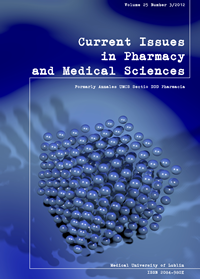Influence of fluphenazine dihydrochloride on model dipalmitoylphosphatidylcholine membranes and human genotoxically damaged lymphocyte cultures
DOI:
https://doi.org/10.12923/j.2084-980X/25.3/a.11Keywords:
chemosensitizing agents, differential scanning calorimetry, fluphenazine dihydrochloride, membrane interactions, P-glycoprotein, rhodamine 123Abstract
The membrane interactions can play a vital role in chemosensitizing activity of fluphenazine dihydrochloride, an inhibitor of P-glycoprotein transport function. In in vitro testings of the influence of fluphenazine dihydrochloride on model dipalmitoylphosphatidylcholine membranes and on human lymphocyte cultures, genotoxically damaged by benzo[a]pyrene, differential scanning calorimetry and rhodamine 123 retention test were applied. The results of both testings shown that the membrane interactions of fluphenazine dihydrochloride in model membrane structure and the chemosensitizing effect of this compound in examined human lymphocyte cultures, depend on its concentration in a sample.
References
1. Boyum A.: Separation of leukocytes from blood and bone marrow Scand. J. Clin. Lab. Invest., 21, 77, 1968.
2. Cieślik-Boczula K. et al.: Interactions of dihydrochloride fluphenazine with DPPC liposomes: ATR-IR and 31P NMR studies J. Phys. Chem. B., 113, 15495, 2009.
3. Drori S., Eytan G.D., Assaraf Y.G.: Potentiation of anticancer-drug cytotoxicity by multidrug-resistance chemosensitizers involves alterations in membrane fluidity leading to increased membrane permeability, Eur. J. Biochem., 228, 1020, 1995.
4. Frenzel J., Arnold K., Nuhn P.: Calorimetric, 13C NMR and 31P NMR studies on the interaction of some phenothiazine derivatives with dipalmitoylphosphatidylcholine model membranes Biochim. Biophys. Acta, 507, 185, 1978.
5. Hendrich A.B. et al.: The alterations of lipid bilayer fluidity induced by newly synthesized phenothiazine derivative Biophys. Chem., 98, 275, 2002.
6. Hendrich A.B. et al.: New phenothiazine-type multidrug resistance modifiers: anti-MDR activity versus membrane perturbing potency Biochem. Biophys. Res. Commun., 304, 260, 2003.
7. Hien T.T. et al.: Molecular mechanizm of suppression of MDR1 by puerarin from Pueraria lobata via NF-κB pathway and cAMP-responsive element transcriptional activity-dependent up-regulation of AMP-activated protein kinase in breast cancer MCF-7/adr cells Mol. Nutr. Food Res., 54, 918, 2010.
8. Jaszczyszyn A., Gąsiorowski K. (2006). Mechanizmy chemoprewencyjnego działania nowo syntezowanych analogów flufenazyny, Borgis®Wydawnictwo Medyczne, W-wa.
9. Jaszczyszyn A., Gąsiorowski K. (2011). Aktywność chemouwrażliwiająca flufenazyny w chemoprewencji późnej nowotworu. In: Promocja zdrowia, profilaktyka i opieka w chorobach przewlekłych - współczesne problemy. T.1. Abramczyk A et al. (editors). Wrocław: A & A Optimed; p.171.
10. Jaszczyszyn A. et al.: New fluphenazine analogues as inhibitors of
P-glycoprotein in human lymphocyte cultures Współcz. Onkol., 16, 332, 2012.
11. Jaszczyszyn A. et al. (2012). Wpływ wysokich stężeń flufenazyny na funkcję transportową glikoproteiny P i na żywotność limfocytów uszkodzonych genotoksycznie in vitro. In: Problemy opieki nad chorym przewlekle. Uchmanowicz I, Rosińczuk-Tonderys J. (editors). Wrocław: MedPharm Polska; p. 347.
12. Li H. et al.: Using rhodamine 123 accumulation in CD8+ cells as a surrogate indicator to study the P-glycoprotein modulating effect cepharanthine hydrochloride in vivo J. Biomed. Biotechnol., 2011, 281651, 2011.
13. Michalak K. et al.: Lipid membrane perturbation caused by some isoflavones andphenothiazines, and the activity of these compounds as inhibitors of multidrug resistance Cell. Mol. Biol. Lett., 7, 293, 2002.
14. Rothnic A. et al.: The importance of cholesterol in maintenance of P-glycoprotein activity and its membrane perturbing influence Eur. Biophys. J., 30, 430, 2001.
Downloads
Published
Issue
Section
License
Copyright (c) 2012 Author

This work is licensed under a Creative Commons Attribution-NonCommercial-NoDerivatives 3.0 Unported License.


